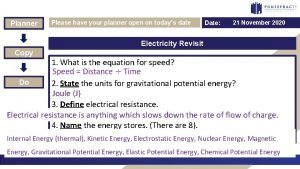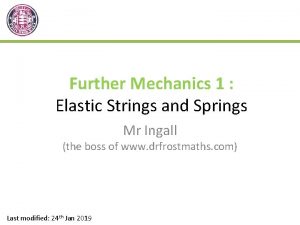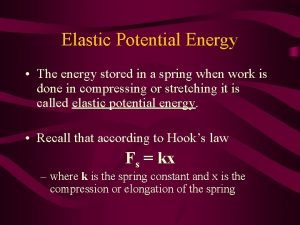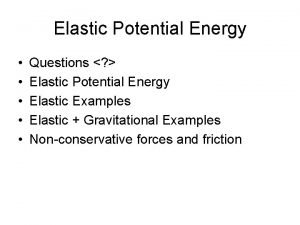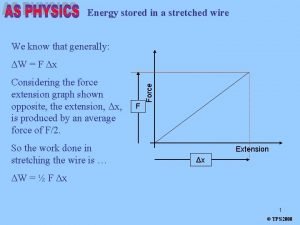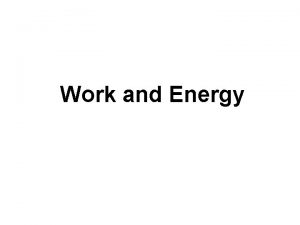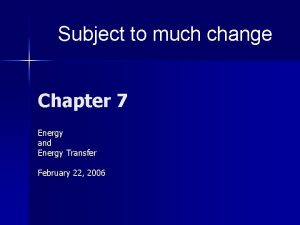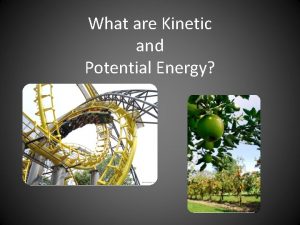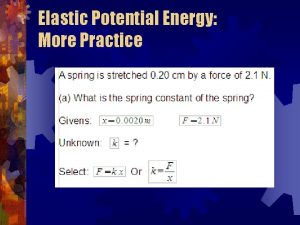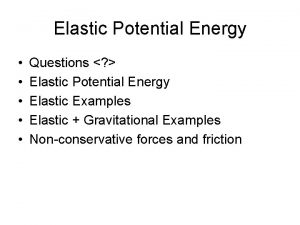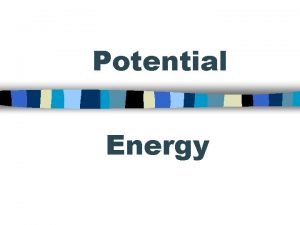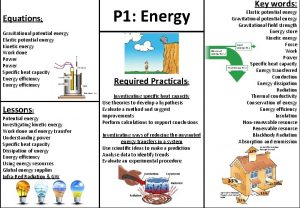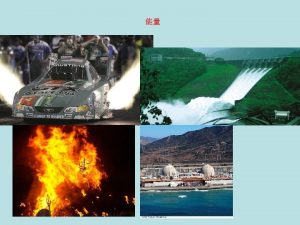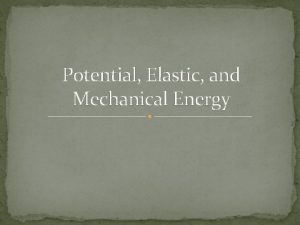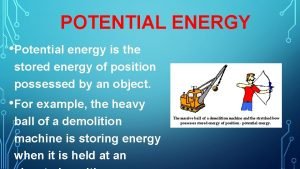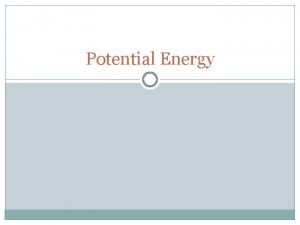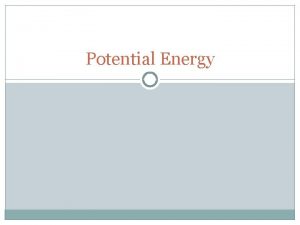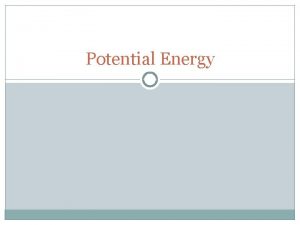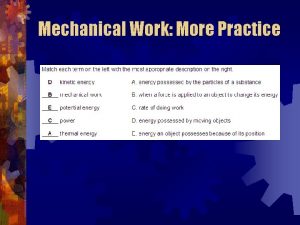Elastic Potential Energy More Practice Elastic Potential Energy


































- Slides: 34

Elastic Potential Energy: More Practice

Elastic Potential Energy: More Practice

Conservation of Mechanical Energy: Learning Goal The student will investigate a simple energy transformation, explain the energy input and output, and calculate the efficiency. (E 2. 5)

Conservation of Mechanical Energy SPH 4 C

Starting with Gravitational Potential An object of mass 3. 0 kg is suspended at a height of 12 m above the ground. Calculate its gravitational potential energy.

Starting with Gravitational Potential An object of mass 3. 0 kg is suspended at a height of 12 m above the ground. Calculate its gravitational potential energy.

Starting with Gravitational Potential An object of mass 3. 0 kg is suspended at a height of 12 m above the ground. Calculate its gravitational potential energy.

Starting with Gravitational Potential An object of mass 3. 0 kg is suspended at a height of 12 m above the ground. Calculate its gravitational potential energy.

Starting with Gravitational Potential An object of mass 3. 0 kg is suspended at a height of 12 m above the ground. Calculate its kinetic energy.

Starting with Gravitational Potential An object of mass 3. 0 kg is suspended at a height of 12 m above the ground. Calculate its kinetic energy. v = 0 so Ek = 0

The Object is Released The object is released and hits the ground at a speed of 15. 3 m/s. What is its kinetic energy when it hits the ground?

The Object is Released The object is released and hits the ground at a speed of 15. 3 m/s. What is its kinetic energy when it hits the ground?

The Object is Released The object is released and hits the ground at a speed of 15. 3 m/s. What is its kinetic energy when it hits the ground?

The Object is Released The object is released and hits the ground at a speed of 15. 3 m/s. What is its kinetic energy when it hits the ground?

And Now We Have Kinetic Energy Calculate the gravitational potential energy of the object when it hits the ground.

And Now We Have Kinetic Energy Calculate the gravitational potential energy of the object when it hits the ground. h = 0 so Eg = 0

And Now We Have Kinetic Energy Our energy has been entirely transformed from gravitational potential energy to kinetic energy.

And Now We Have Kinetic Energy Our energy has been entirely transformed from gravitational potential energy to kinetic energy. But the total mechanical energy of the object (potential energy + kinetic energy) has not changed.

Conservational of Mechanical Energy In general, if no work is being done on an object by an outside force, the total mechanical energy of the system will remain constant:

In Real Life Note that in real life, energy is never transformed with 100% efficiency: a ball dropped from a given height will never bounce back up to that same height. Some energy is always “lost” as heat energy or sound energy because of friction. However, just as we often neglect friction, we will often neglect these losses.

Efficiency is the ratio of useful energy or work output to the total energy or work input:

Efficiency is the ratio of useful energy or work output to the total energy or work input (written as a percent):

Efficiency Example 1 A model rocket engine contains explosives storing 3500 J of chemical potential energy. Calculate how efficiently the rocket transforms stored chemical energy into gravitational potential energy if the 0. 50 kg rocket is propelled to a height of 1. 0 x 102 m.

Efficiency Example 1 A model rocket engine contains explosives storing 3500 J of chemical potential energy. Calculate how efficiently the rocket transforms stored chemical energy into gravitational potential energy if the 0. 50 kg rocket is propelled to a height of 1. 0 x 102 m.

Efficiency Example 1 A model rocket engine contains explosives storing 3500 J of chemical potential energy. Calculate how efficiently the rocket transforms stored chemical energy into gravitational potential energy if the 0. 50 kg rocket is propelled to a height of 1. 0 x 102 m.

Efficiency Example 1 A model rocket engine contains explosives storing 3500 J of chemical potential energy. Calculate how efficiently the rocket transforms stored chemical energy into gravitational potential energy if the 0. 50 kg rocket is propelled to a height of 1. 0 x 102 m.

Efficiency Example 1 A model rocket engine contains explosives storing 3500 J of chemical potential energy. Calculate how efficiently the rocket transforms stored chemical energy into gravitational potential energy if the 0. 50 kg rocket is propelled to a height of 1. 0 x 102 m.

Efficiency, alternately Efficiency is also the ratio of useful power output to the power input:

Efficiency Example 2 A 120 -W motor accelerates a 5. 0 -kg mass from rest to a speed of 4. 0 m/s in 2. 0 s. Calculate the motor’s efficiency.

Efficiency Example 2 A 120 -W motor accelerates a 5. 0 -kg mass from rest to a speed of 4. 0 m/s in 2. 0 s. Calculate the motor’s efficiency.

Efficiency Example 2 A 120 -W motor accelerates a 5. 0 -kg mass from rest to a speed of 4. 0 m/s in 2. 0 s. Calculate the motor’s efficiency.

Efficiency Example 2 A 120 -W motor accelerates a 5. 0 -kg mass from rest to a speed of 4. 0 m/s in 2. 0 s. Calculate the motor’s efficiency.

Efficiency Example 2 A 120 -W motor accelerates a 5. 0 -kg mass from rest to a speed of 4. 0 m/s in 2. 0 s. Calculate the motor’s efficiency.

More Practice Conservation of Energy Lab Activity For Wednesday: Roller Coaster Construction!
 Lirik lagu more more more we praise you
Lirik lagu more more more we praise you More more more i want more more more more we praise you
More more more i want more more more more we praise you Mxgxh formula
Mxgxh formula Example of potential energy
Example of potential energy Elastic strings and springs
Elastic strings and springs Chemical potential energy examples pictures
Chemical potential energy examples pictures Elastic potential energy
Elastic potential energy Elastic potential energy questions
Elastic potential energy questions Elastic potential energy real world examples
Elastic potential energy real world examples A student places her 500g physics book
A student places her 500g physics book Energy stored in wire
Energy stored in wire Energy move
Energy move Elastic potential energy formula
Elastic potential energy formula Potential energy
Potential energy What is elastic potential energy
What is elastic potential energy Microscopic structure of hyaline cartilage
Microscopic structure of hyaline cartilage Potential energy
Potential energy 5 examples of potential energy
5 examples of potential energy Volts to ev
Volts to ev Electric potential vs electric potential energy
Electric potential vs electric potential energy Joules to newtons
Joules to newtons Which demand curve is more elastic
Which demand curve is more elastic Electrical potential energy formula
Electrical potential energy formula Gravitational kinetic energy equation
Gravitational kinetic energy equation Examples of mechanical energy at home
Examples of mechanical energy at home Gravitational potential energy vs kinetic energy
Gravitational potential energy vs kinetic energy Potential vs kinetic energy
Potential vs kinetic energy You and your friend both solve a problem involving a skier
You and your friend both solve a problem involving a skier Mechanical advantage
Mechanical advantage Potential energy units
Potential energy units The more you take the more you leave behind
The more you take the more you leave behind The more you study the more you learn
The more you study the more you learn Aspire not to have more but to be more
Aspire not to have more but to be more Law of inertia definition
Law of inertia definition Knowing more remembering more
Knowing more remembering more


